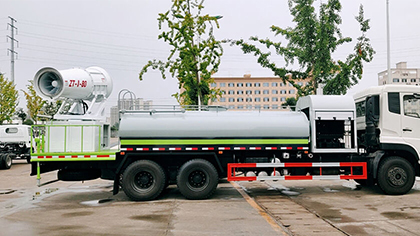In a recent endeavor to combat urban smog and industrial
dust, a group of Thai customers invested in advanced
vehicle-mounted fog cannons. This strategic purchase has
not only enhanced their dust suppression efforts but also
significantly improved air quality in various industrial and
urban settings.
The customers, comprising municipal authorities and
private enterprises, operate in environments ranging
from construction sites and municipal roads to coal
yards and power plants. Their primary objective was to
find a robust solution for dust control and cooling in
areas with high dust concentration.
Before the acquisition of fog cannons, the clients faced
several challenges:
1.High Dust Levels:Urban smog and industrial dust were
affecting air quality and visibility.
2.Regulatory Compliance:Adherence to environmental
regulations required effective dust suppression measures.
3.Public Health Concerns:Elevated dust levels posed health
risks to workers and nearby residents.
The fog cannons purchased by the Thai customers are
capable of atomizing tap water into fine water mist
particles ranging from 50 to 200 microns. This water mist
is then sprayed at high altitudes, providing an effective
solution for dust suppression and cooling.

Features and Benefits:
1.Versatility:Suitable for various environments such as
urban areas, construction sites, coal yards, power plants,
and ports.
2.Efficient Dust Suppression:The water mist fully blends
with dust particles,forming clusters that rapidly settle
due to gravity, effectively reducing dust levels.
3.Cooling Effect:In addition to dust suppression, the fog
cannons also provide a cooling effect, enhancing comfort
in high-temperature areas.
4.High Altitude Reach:The ability to spray water mist at high
altitudes ensures comprehensive coverage of large areas.
Implementation:
The fog cannons were mounted on vehicles, allowing for
mobility and flexibility in addressing dust suppression
needs across different sites. The implementation process
included:
1.Site Assessment:Evaluating specific dust control
requirements for each location.
2.Training:Providing operational training for staff to ensure
efficient use of the equipment.
3.Regular Maintenance:Establishing a maintenance schedule
to keep the fog cannons in optimal condition.
Results:
Since the deployment of the vehicle-mounted fog cannons,
the Thai customers have reported significant improvements:
1.Reduction in Dust Levels:A noticeable decrease in airborne
dust particles has been observed, enhancing air quality.
2.Compliance with Regulations:The fog cannons have enabled
customers to meet stringent environmental regulations.
3.Improved Public Health:Lower dust levels have contributed
to better health outcomes for workers and residents.
4.Positive Feedback:The effectiveness of the fog cannons
has garnered positive feedback from both clients and
regulatory bodies.
Conclusion:
The successful implementation of vehicle-mounted fog
cannons by Thai customers highlights the effectiveness
of this technology in addressing urban and industrial
dust challenges. The comprehensive dust suppression
and cooling capabilities have made a significant impact,
ensuring compliance with environmental standards and
improving public health.
By investing in fog cannons, these Thai customers have
demonstrated a commitment to enhancing air quality
and safeguarding the environment, setting a benchmark
for other regions facing similar challenges.










